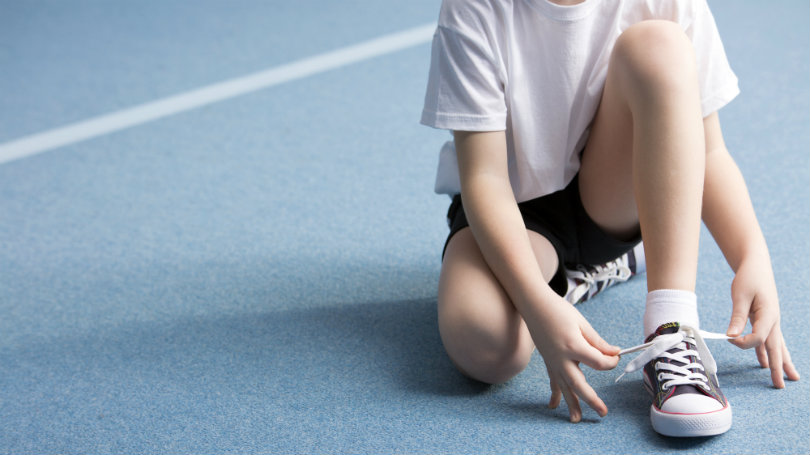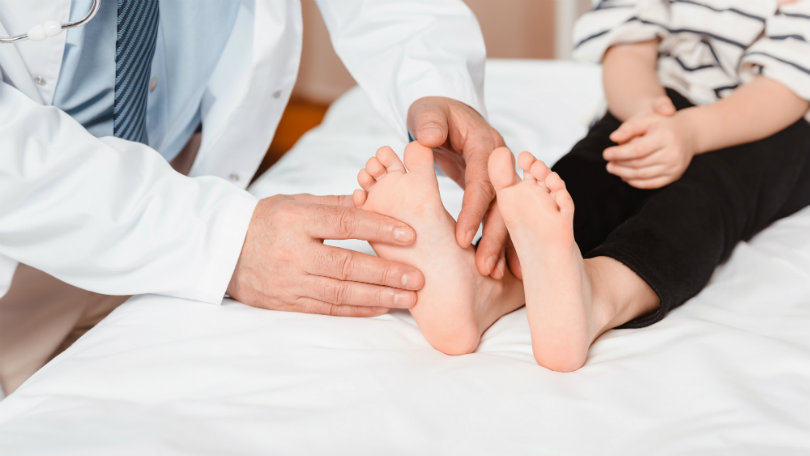They Grow Up So Fast—And So Do Their Feet
That’s parenthood for you. One day, you’re holding your child for the first time. The next, you’re sending them off for their first day of school, or teaching them to drive, or helping them get over their first breakup.
While you’re watching them grow up, make sure you don’t forget to keep an eye on their growing feet, too. Foot problems in childhood, when left untreated, can lead to chronic pain and even deformity in adulthood. Yet they are frequently overlooked.
Kid Shoes: The Importance of Finding the Right Fit
“They grow up fast” is a pretty literal description of what happens to a child’s feet, pretty much from infancy all the way through adolescence. It only takes about three months for a typical toddler to outgrow his or her shoes—long before the shoes themselves actually appear worn out. Even though foot growth gradually slows over time, through age 12 or so kids could still be outgrowing their shoes more than once per year.
Kids won’t always tell you if their shoes are too tight, either—especially the young ones. Nerve endings in their feet aren’t necessarily well developed yet, so tight shoes might not even hurt.
So perhaps it isn’t surprising that, according to a study by a Swiss research team, almost two thirds of children were wearing shoes that were too small—and almost one in five were wearing shoes two full sizes too small. Even more alarming? More than half of parents said that they had never measured their child’s foot length.
Shoes that don’t fit properly can contribute to problems with foot pain, posture, gait, or even foot deformities—now and in the future. So it’s important to get this part right!
How to Tell if Your Child’s Shoes Are Too Tight
Since you can’t necessarily trust your child to reliably report shoes that are too tight, you might have to do a little detective work on your own.
- Test the fit for your child once every couple of months. When you first fit a shoe, there should ideally be about half an inch of wiggle/growing space between the front of the shoe and the end of the longest toe. With your fingers, push down on the shoes with your child standing normally in them. If the toes are hitting the front of the shoes, they’re too small.
- Are the shoes beginning to bow out or bulge along the sides? They might be too narrow.
- Do your child’s feet appear reddened or swollen? Tight shoes can cause this.
- Your child may be constantly pulling off his or her shoes because they’re tight or uncomfortable.
- If your child seems to frequently trip or stumble over their own feet, or suddenly withdraws from active play, pain related to tight shoes may be to blame.
Shoe Sizing and Shopping Tips for Your Kids
So let’s say your child has outgrown their old pair of shoes. How do you rectify that situation?
- Unless the child is very young (i.e., pre-walking), always buy new shoes rather than used or hand-me-down. Because they can mold and compress under the weight of the original owner, used shoes can be very uncomfortable (or even damaging) for a child.
- Always take your child shoe shopping with you so they can test the fit.
- There should be about a thumb’s width of “wiggle space” between the front of the shoe and the longest toe (usually the first, sometimes the second). The heel should be firmly cradled so the shoe doesn’t slide around, but not too tight either—you should be able to slide your index finger (down to the second knuckle) between the heel and the back of the shoe when the shoes are laced.
- Always measure your child’s feet—length and width—before you start trying on pairs.
- Shoes should be tested with the same type of socks that your child will be wearing with that pair of shoes. Socks add “width” to the feet, so they’re an important part of finding the right fit!
- Resist the urge to buy too-big shoes that your child will “grow into.” Shoes that are too big and slide around on your child’s feet can be just as painful and damaging as shoes that are too tight.
- Let your child walk around the store for a bit in each pair you test out. Yes, new shoes might feel a little strange at first, but they should also feel comfortable. Shoes should never need to be “broken in.”
Feet Change as They Grow
Feet don’t simply get bigger as your child grows older. It’s more complicated than that. In fact, their shape, structure, and even the way they move and function change quite a great deal over the first two decades of life.
For example, you may notice that your little one’s arches might flatten when they are bearing weight, only to reappear if they’re sitting or standing on tiptoes. This is actually quite normal for kids under around age 5 or so. Bones are still very soft and flexible at this stage, and the surrounding connective tissues haven’t gotten strong enough to develop and stabilize a strong arch.
It’s also not uncommon for children to have feet that appear rotated inward or outward when they walk. Most of the time this resolves itself naturally during school age, although more serious case may require some intervention (or even surgery) to correct.
It’s not realistic to expect that your young child is going to look just like a small adult on their feet—after all, they wouldn’t call them “toddlers” if they didn’t toddle!
However, if you do notice that your child’s feet or legs don’t seems to look completely normal, or show any signs of pain or unusual discomfort or fatigue, bring him or her to see us at the Wisconsin Foot Center. Take complaints of pain seriously, and watch for signs like sudden disinterest in physical activities or frequently requesting to be carried after minimal exercise.
Again, it is possible that the problem will work itself out naturally. However, if additional intervention is required, it’s better to find out early. Foot problems that emerge in childhood should be fixed as soon as possible so that troubles don’t persist into adolescence and adulthood.
We want your children to be happy and healthy, with good feet that can carry them through throughout life! If you need to schedule an appointment with us for you and your child, please call our Hales Corners office at (414) 425-8400 today.
Request an Appointment
© Wisconsin Foot Center. All Rights Reserved. Website & Marketing By Podiatry Growth



